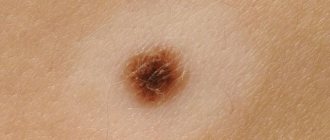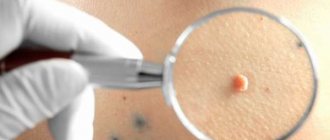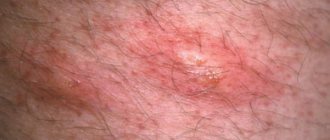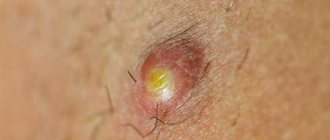Causes of appearance in the groin
Moles can appear on a person's skin immediately after birth, during the first years of life and in adulthood. Studies have shown that the following factors contribute to the appearance of nevi on the body:
- heredity;
- hormonal fluctuations in the mother during the period of waiting for the baby or puberty;
- poisoning of the expectant mother with toxic substances;
- exposure to radiation on the body of a pregnant woman;
- various infections suffered during pregnancy.
Birthmarks and moles form on the human skin due to the accumulation of pigment in the cells - melanin, which is produced by melanocytes. The cells provide a person with protection from exposure to ultraviolet rays.
In adulthood, neoplasms in various areas of the body can appear due to trauma to the dermis, exposure to ultraviolet radiation or radiation, or viral infections.
Healthy, intact nevi that do not change size, color, shape and structure should not cause discomfort or cause a feeling of anxiety. If the formation hurts, itches, or changes, it threatens to degenerate into melanoma and requires consultation with a dermatologist.
Why do nevi grow?
Moles often appear in the groin with age. Sometimes they resemble birthmarks, but there is a difference. Birthmarks appear immediately at birth, and nevi form at a more mature age. A mole in the groin in men and women can occur due to the following factors:
- hormonal imbalances;
- exposure to solar radiation;
- influence of toxic substances;
- permanent injury to the skin;
- heredity.
The formation of nevi is influenced by the pigment melanin, which accumulates in the cells of the skin. Often a mole in a woman’s groin occurs during pregnancy. This is due to hormonal imbalances. Often, if nevi appeared while expecting a child, they will disappear after birth.
How to distinguish it from other skin formations
A mole between the legs is confused with papillomatosis; in the groin you can see a cluster of hanging warts, vaguely similar to nevi. Papillomas arise on the human dermis as a result of infection or increased activity of the dormant human papillomavirus. Small, flesh-colored growths begin to appear on the skin, which are easy to touch and tear off.
A mole differs from a papilloma in that it is brown, pink, black, blue or red in color, the surface is flat or slightly convex, the shape is regular, round, and the boundaries are clear. A dermatologist treats and examines nevi; it is better to show papilloma to a dermatovenerologist.
Ordinary neoplasms do not require treatment unless they are located in traumatic areas where they must be removed. Papillomas require complex treatment, removal, and pose a danger to the person on whose skin they are located.
A mole in the perineum differs from skin and venereal diseases according to the following characteristics:
- STDs and fungal diseases appear on the skin of the perineum in the form of papules, warts, lichen, ulcers, pustules, spots.
- A healthy mole does not bring discomfort to a person; skin manifestations of STDs and fungal infections itch, become inflamed, and break out.
- Skin and venereal diseases occur due to allergens, fungi, parasites or microbes. Moles appear during natural processes in the dermis.
Unpleasant sensations on the skin in the groin area, itching, tingling or tingling should be a reason to consult a doctor. If the symptoms are caused by an STD, they should be treated by a venereologist.
What does this indicate?
Ancestors believed that the location of a dot or spot on a person’s body promised something good or negative on the path of life. In ancient times, people believed that if a person had a mark on the right side of his crotch, he would be rich and noble, but prone to disease. If the spot was located on the left, then the person will live in need, illnesses will haunt him.
Moleosophy – the science of moles – interprets marks in the groin as follows:
- A formation in the perineum characterizes a person as a capable person, but not always able to cope with emotions and desires.
- A mark in the groin indicates that its owner may have problems that do not have a solution.
- A spot in the groin of a man characterizes him as a passionate lover.
- Moles in the perineum in women indicate that the owner is experienced in love and love games.
People who have marks between their legs give birth to beautiful children.
What does a birthmark on the lower part of the right buttock mean?
For men, she promises a kind character, pronounced individualism, as well as charm. The owner of such a mark is a good friend for both men and women. These guys make excellent husbands, thanks to their warm character, ability to win a woman’s attention, showiness and self-confidence. They love the comfort of home. Family happiness is an important aspect in the life of such a man.
The owner of a birthmark on the lower right buttock can earn a considerable fortune. He is lucky in money matters. Such a person will make efforts to be a wealthy person in old age. By the age of thirty, he will definitely occupy a solid position in society. Having a family or the desire to create one stimulates him to do this. We are talking about good family men with a regular income, pleasant to talk to.
The nature of a woman with a similar mark is to skillfully hide her true qualities - cunning, greed, anger. She is lazy and selfish; such ladies cannot be taught to care about anyone other than themselves. Thanks to her ability to appear better, she gains a reputation as a femme fatale. He is also distinguished by prudence - he is friends with those who are useful.
She will not make a wife in the popular sense. Will marry only the one who fulfills all desires. She has many lovers and needs a permanent man to satisfy her material needs. She has good taste and will win any heart; many people have no idea what this woman is like.
Methods for safely removing a mole in the groin
There are several ways to remove a mole in the perineum. This should be done after examination by a doctor and selection of the optimal method. Doctors do not recommend removing nevi in the groin using folk or pharmaceutical remedies on your own. The neoplasm can have deep roots and be dangerous to health.
Nevi in the perineum are removed using the same methods as spots on the legs or fingers:
- Laser removal. The procedure is carried out with a laser, which removes layers of formation on the dermis, lasts no more than 10 minutes, and local anesthesia is used. The manipulation is suitable for eliminating small tumors. During execution, no bleeding is observed, and there is no possibility of infection entering the wound. There are no scars left.
- Cryodestruction. The tumor is removed using liquid nitrogen; the procedure lasts 5-10 minutes. The patient does not feel pain; a substance is applied to the nevus during manipulation. It becomes covered with a crust, which falls off, and the mole is removed by the roots. The disadvantage of this method is that liquid nitrogen can destroy healthy tissue.
- Electrocoagulation. The technique involves the use of high-frequency current on the tumor. There is no bleeding or infection during the operation; adjacent healthy tissue is not affected. Before the procedure, the doctor numbs the skin with a gel.
- Radio waves. Nevi can be removed using a radio knife. The pigmented tumor rarely grows back after the procedure. The device makes an incision in the area of the nevus, removes it painlessly, no infection gets into the wound, and there is no bleeding.
- Surgical excision. Dermatologists advise using this method to remove large tumors that can bother the patient and are often injured and inflamed. The method involves the use of anesthesia, the patient needs rehabilitation after the operation, and a scar remains on the skin after the procedure.
The doctor chooses the method of removing a mole on the dermis; it depends on the size of the spot, its shape, color, nature of formation, structure and other indicators.
Is it dangerous
A healthy nevus on any area of the body does not cause harm to the human body. But a mole in the perineum has a risk of degenerating from a benign neoplasm into a malignant one (melanoma - skin cancer).
Noteworthy marks in the groin are:
- They change in size and become larger.
- They bring a feeling of tingling and itching.
- They became lumpy, uneven, and covered in cracks.
- They began to bleed, and pus began to ooze out.
- The borders of nevi look uneven.
Dermatologists believe that neoplasms in the perineum that appear in old age are dangerous; they represent an accumulation of more than 50 marks, inflamed spots, and large birthmarks.
Mole on the butt - general meaning, signs
From the point of view of signs, there is no difference between moles and birthmarks on the buttocks. And not all esotericists share these interpretations based on the location of the nevi.
A birthmark on the butt is a weak, overly soft character. It will interfere throughout life when this quality is not worked on. People with this mark are lazy and helpless in difficult life circumstances. They get used to living by other people’s opinions and never have their own. Laziness practically becomes the main cause of poverty.
People with such birthmarks have an increased sexual appetite and are able to attract partners. The opposite sex likes them, but they prefer to choose spouses who are wealthy—the owners of spots on their butts do not want to work.
Possible complications and precautions
A complication of a mole in the groin is degeneration into melanoma. Marks that are constantly injured during shaving and depilation are at risk.
Doctors advise people with tumors in the perineum to take the following precautions:
- Depilation should not be done in the intimate area.
- Avoid exposure to ultraviolet radiation, do not sunbathe in a solarium without underwear.
- Show your nevus regularly to your doctor.
- Monitor changes in hormonal levels.
- Try not to expose the stain to injury.
Compliance with the above precautions will allow you to notice signs of nevus degeneration in time and choose the appropriate elimination method.
Flat brown moles in the groin area do not cause discomfort to a person and do not need to be removed. They are not a cosmetic defect. But hanging neoplasms of flesh-colored, red and other colors must be regularly examined by a dermatologist.
Preventive measures
In order to avoid the appearance of nevi in the groin area, it is necessary to avoid the causes of their appearance.
Although moles in the groin appear much less frequently from ultraviolet radiation. Than on the face or body, but you still need to try to sunbathe less in a solarium or in direct sunlight. Another preventive measure to prevent the appearance of moles in the groin is the correct choice of underwear. It should be comfortable and not rub the skin.
Moles in the groin area rarely require removal and almost never cause aesthetic discomfort to a person. But still, if you find moles in your groin, you should monitor their condition and if signs of growth or changes in their color and texture appear, immediately go to see a specialist.
A mole in the groin is a benign formation on the body, formed at the site of an accumulation of melanocytes. Nevus removal is often required due to the possibility of injury from clothing or hair removal.











